To finally eat enough - the Langar kitchens of the Sikhs in their Gurdwaras#
by

Foto: G. Jontes, under CC BY 4.0

Foto: G. Jontes, under CC BY 4.0
Unlike believers of most other religions, Sikh men can be identified immediately because of their outer appearance. Magnificent turbans and flowing beards attract attention. Their religious, social and cultural understanding, their magnificent temples and their bravery distinguish them from their neigbours. In relation to the billions of Hindus and Muslims, Sikhs make up only 1,9% of the Indian population, similar to the 2.3% of Christians.

Foto: G. Jontes, under CC BY 4.0
Most of the Sikhs live in Punjab/Punjabi. Their religion originated in this area. Therefore, the Holy Book, containing the wisdom teachings of their last gurus, is written in Punjabi, an Indo-Aryan/Indo-Germanic language with its own writing. 2.8% of the Indians speak Punjabi as their mother tongue. Panjabi has an own dextrograde writing system (i.e. the writing is done from right to left) with markings of the vowels. This writing system is called Gurmukhi (meaning "Head of the Guru"). In Punjabi the word „Sikh“ has the meaning „student, follower“.
Sikhism, as it is called by the sience of religion, originated in Punjab region during the 15th century. Prior to becoming a preacher and founder of Sikhism, Guru Nanak (1469-1539) was also travelling to Persia and Arabia as a merchant. He taught a formless Creator God and emphasized the Unity of Creation. As mystic, he was in search for peace of the individual with God and considered his doctrine as a religion of salvation. He also combines the monotheism of the Muslims with the karmic thinking and the doctrine of rebirth of the Hindus. His main motto is: God is the only one (punjabi ik onkar). There are no religious dogmas in the teachings of the Sikhs. The godly life should permeate the everyday life.

Bibliothek Jontes, under CC BY 4.0
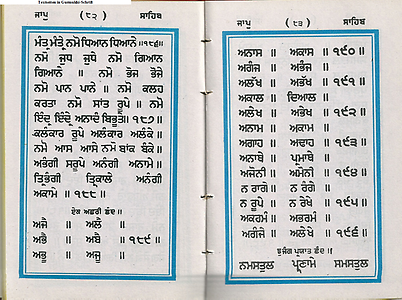
Bibliothek Jontes, under CC BY 4.0
The high ethical requirements for this for India completely new religion are summarized in six main rules of live which one seeks to achieve: The purity of thinking (do no one any harm) – The purity of tongue (do never one judge too rigorously) – The purity of acting (do not distruct anything that others have created by working) - Forgive those who speak unkind about you – Practice to bear physical and mental problems – Help the poor and weak, even if it costs your own life.
These teachings are based on an unconditional trust in God as it is expressed in the following hymn of Guru Amar:
My mind, always focus on God.
Be with God, my soul,
Forget your worries,
So the Lord will remember you
And will take care of your daily hardships.
The Lord is omnipotent and perfect
In every minute detail.
(Translated into German by Heinz Gstrein, in "Das unsagbare Glück", Vienna, 1983 – and from German into English in "The Unutterable Happiness", Vienna 2016, by of the translator of this essay)

Foto: G. Jontes, under CC BY 4.0
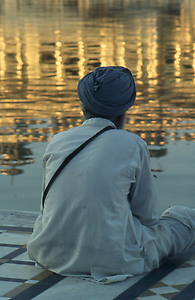
Foto: G. Jontes, under CC BY 4.0
Guru Nanak rejected also social hierachies like the Hindu caste system. Men and women are equal and share the same rights. They regard themselves as brothers and sisters, as also is appparent from their names. Male Sikhs have Singh (Lion) and female Sikhs have Kaur (Princess)attached to their first and family name at the end.
The high esteem of women is expressed in this beautiful hymn:
From a woman we are received,
From a woman we are born.
With a woman we get engaged and married.
Women are friends and partners for life.
Without women people die out.
Without women the good dies in us.
Women are the ones who socialize.
Who can therefore anyone think of women as lower and weaker?
(Translation of Heinz Gstrein into German, Das Unendliche Glück - The Infinite Happiness, Vienna 1983 – and from German into English by the translator of this essay)
Die Geschichte der Sikhs ist eine sehr bewegte, die durch Jahrhunderte hindurch in kämpferischen und opferfreudigen mit den islamischen Herrschern zum Ausdruck kam. Bekanntlich hatten die muslimischen Moguln seit dem Beginn des 16. Jahrhunderts über ganz Nord- und Mittelindien ausgedient. In dieser Zeit wurde aus den zuvor eher hingebungsvollen friedlichen Menschen eine verschworene kampfbetonte fast ordensmäßig organisierte Gemeinschaft, die von den Muslimen nie ganz in die Knie gezwungen werden konnte.
The history of the Sighs is characterized by century-long conflicts with Islamic rulers. As of the beginning of the 16th century, the Islamic Mogules expanded into northern and southern India. During this period, peaceful and devoted people changed into a warlike, tightly organized community that could not be entirely be defeated by tme muslim intruders.
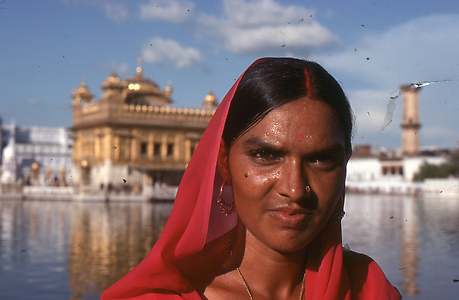
Foto: G. Jontes, under CC BY 4.0

Foto: G. Jontes, under CC BY 4.0

Foto: G. Jontes, under CC BY 4.0
Guru Nanak had nine successors. The last Guru Gobind Singh (1666-1708) was killed by Muslims. Before his execution, he wa still able to pass on the message that no more Gurus are to be be elected any more. From this very moment, Sikhs will be guided by a collection of wisdom sayings of Guru Nanak and his successores.
This book is called Guru Granth Sahib meaning „Our Master, the revered teacher is here recorded in writing". In old India, Grantha was a book written on palm leafs. It is the centre of attention of the teachings in every Gurdwara. Gurdwara is a place of worship within Sikhism and may be referred to as Sikh temple.
In the Golden Temple of Amritsar armitsar,punjab , the teaching takes place in the middle of the holy lake from morning to late in the night. The name Amritsar originated from Sanscrit amria sagar meaning „lake of potion of immortality“. Readings are held by respected men. Priests are not known in Sikhism. A small ensemble of musicians and singers represents an harmonical tonal background of the readings. Their music contributes to the incredibly beautiful atmosphere of this ceremony.
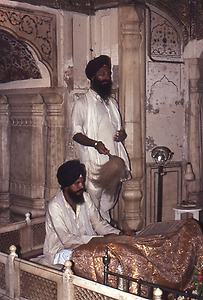
Foto: G. Jontes, under CC BY 4.0

Foto: G. Jontes, under CC BY 4.0
The reading ends at midnight. Then the book is closed, wrapped in precious cloth and carried with a palanquin in a procession to a special building, where the book is put to sleep. The following day it is returned to the Golden Temple. The reading does not start where it ended the day before, but continues on the page appearing by itself after opening.

Foto: G. Jontes, under CC BY 4.0
The reading takes place in a Gurdwara temple. Gurdwara means „Gateway to the Guru“. A Gurdwara is open to all people without distinction of background. This is also symbolized by the fact that there are four doors pointing to the main directions. The entire complex als contains administrative buildings, storerooms and kitchens. There is also a huge common kitchen/canteen, called „Langar“. Every day, food is served for free to thousands of visitors to ensure that all people can eat as equals.
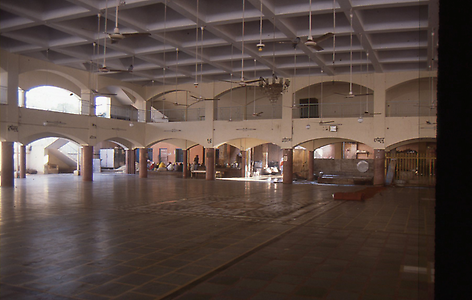
Foto: G. Jontes, under CC BY 4.0
Galleries with pictures of Gurus and heroic Sikhs are shown here. Until today, the history of Sikhs has been a violent one. Political fanatism as well as use of violence led also to the assassination of Indira Gandhi by her Sikh life guard.
Boys are admitted to the Gurdwara at an age from 12 to 18 by tieing them the turban for the first time. This initiation ceremony is called „Tieing Turban“ and can be compared with the First Communion or Confirmation in the Catholic church. Thereafter, a sweet drink is given to him, in which a sword has been plunged. From this very moment, the boy is a full member of the community and is allowed to wear the five symbols, teh five Ks. In Punjabi, each of these five symbols starts with the letter K.
The five symbols are:
Kesh: Lifelong uncut and well-groomed hair, to be covered with a turban (Punjabi dastar). The non-cutting of hair and beard is to emphasize the non-intervention in God‘s work in nature. Out of respect the hair tied with a knot is covered. Before entering a Gurdwara, the head has to be covered with a scarf. Objects made from leather as well as tobacco and alcohol are not allowed to be taken into a Gurdwara. Growing hair is said to produce special vitality. An interesting link to the biblical Samson!
Kangha: Kangha is a wooden comb with an iron layer fixed under the turban. It symbolizes that people should always be guided by discipline and cleanliness. Bathing and washing the hair are parts of the canon of life.

Foto: G. Jontes, under CC BY 4.0

Foto: G. Jontes, under CC BY 4.0
Kirpan: Kirpan means sword. Men should always help the weak and those who are in need for protection, even if that means to use the weapon. Nowadays, they swords have been reduced in size to daggers, worn either under their clothes or visibly. Sikhs have even the right to carry this symbol on airplanes.
Kara: An iron bracelet worn on the left wrist symbolizes the devotion to the Guru. Due to the shape, rings represent symbols of eternity in many cultures.
Kachera: These are cotton underpants reaching to the knees which are not worn by Hindus and Moslems. One can only see them when Sikhs take a bath in the holy lake. It is supposee to remind the wearer of mental control over lust. Among Sikhs, doing good is of high priority. Those who own enough – there are also very rich Sikhs – contribute generously to the public. This is demonstrated most visible in the dining areas of Amritsar where about five thousand visitors a day are guests, irrespective of religious confession, gender and origin. There are Indians of all social classes, beggards and citizens. Everybody is invited and receives food prepared in huge kitchens.
Thousands of visitors are sitting in long rows on a carpet. At the entrance, they receive a plate devided into three parts. One part is used for vegetables (punjabi sabzi), the other for lentils (dal) and the last for two unleavened flatbreads (roti). Metal dishes are ritually safe for Sikhs, even if non-Hindus are using it. Usually, Indians form a spoon from a piece of bread, which is put into the sauce. On this occasion, they receive a spoon because of sanitary reasons. There is no opportunity for thousands of people to wash their hands at the same time, and the holy lake is of course taboo for washing the hands.

Foto: G. Jontes, under CC BY 4.0

Foto: G. Jontes, under CC BY 4.0
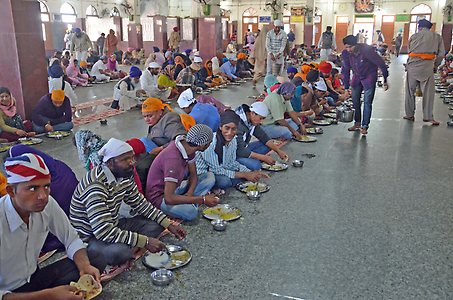
Foto: G. Jontes, under CC BY 4.0
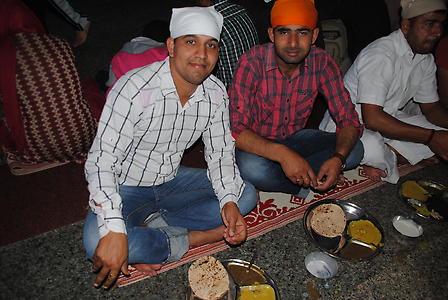
Foto: G. Jontes, under CC BY 4.0

Foto: G. Jontes, under CC BY 4.0

Foto: G. Jontes, under CC BY 4.0

Foto: G. Jontes, under CC BY 4.0

Foto: G. Jontes, under CC BY 4.0

Foto: G. Jontes, under CC BY 4.0

Foto: G. Jontes, under CC BY 4.0
People are offered water(panhi)in metalic bowls. No other drinks are served. For many poor people such a meal has saved their life for antoher day. Maybe they will return also the next day.
There is no meat offered. For Sikhs, meat as food is not a taboo. Hindus do not eat beef, Muslims and Jews don’t eat pork. In the book Guru Granth Sahib, it is written: “Fools argue about meat and forget the meaning of spirituality and meditation”. There exists just one ethical requirement: An animal to be used for food has to be killed with one single strike. Sikhs do not eat meat slaughtered ritually as in Islam or in Hinduism (halal and kosher).
All intoxicants, including tobacco and alcohol are forbidden.
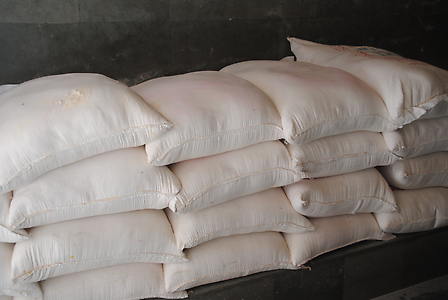
Foto: G. Jontes, under CC BY 4.0

Foto: G. Jontes, under CC BY 4.0
Men, women and young people are working on a voluntary and honorary basis. In and in front of the kitchens, they are preparing vegetables, peeling garlic and mixing bread dough for the flatbread. They heat the ovens in which thousands of flatbreads are being baked. Bread is handed over to the visitors at the right moment. In huge, still wood-fired kettles sauces are cooked. Veiled in steam, strong men are stirring th sauces in kettles with huge spoons. Food is then distributed to the visitors by volunteers.
As a culinary base, flatbread plays a major role. To be able to distribute it ready for eating, many people are busy with preparing the bread dough, rolling and baking.

Foto: G. Jontes, under CC BY 4.0

Foto: G. Jontes, under CC BY 4.0

Foto: G. Jontes, under CC BY 4.0
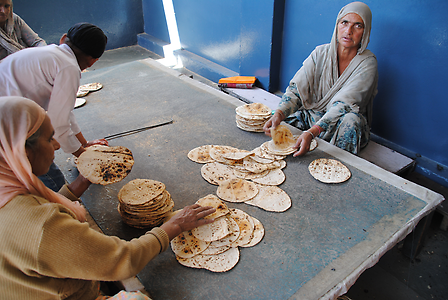
Foto: G. Jontes, under CC BY 4.0
Once the visitors finish their food, the dishes are collected and washed up. Even some elegantly dressed women from Sikh families who gave donations, are washing the dishes, cleaning the floor and are doing other low labor. This would not be reasonable for Hindu and Muslim women.

Foto: G. Jontes, under CC BY 4.0

Foto: G. Jontes, under CC BY 4.0
Apart from this free meal, visitors receive also a sweet hot dish when entering the temple. It symbolizes a devotional food (prasad), that can be eaten right away. The cooking of prasad takes place in a special kitchen. It can be also bought and taken home.

